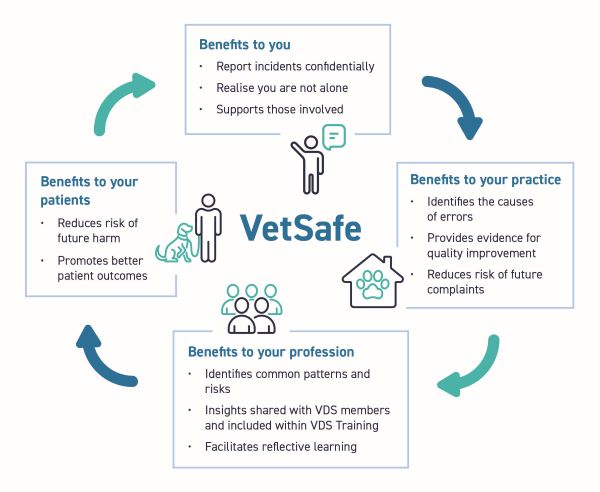
VetSafe: Learning to Build Safer Systems
VetSafe is the Veterinary Defence Society’s secure, confidential adverse event reporting system. It allows VDS members to log instances of care in practice that may not have gone the way we, veterinary professionals, intended, or might have caused harm to patients, so that we can learn from these events. At its simplest, VetSafe is a tool to help VDS members understand how the practice system is working and identify places where it could be improved. Through the data gathered and insights this generates, VetSafe empowers VDS members to embed solutions that reduce patient harm and improve outcomes for all involved.

A system is ‘an interconnected set of elements that is coherently organized in a way that achieves something’ (Meadows, 20081). In a veterinary practice these elements include the buildings, the equipment, how work is organised through processes and standard operating procedures (SOPs), all the people on the veterinary team, our clients and of course our patients. It also includes less tangible things like the relationships between people and the organisational culture. Our practices are socio-technical systems and understanding the ongoing interaction between these technical and social aspects is at the heart of keeping our practice systems operating safely (Roberts et al., 20222). VetSafe helps teams deliver safer veterinary care. Safer for our patients, but also safer for us by helping teams create workplaces that support us to deliver the best possible care. Whilst safety is often considered as the absence of accidents and incidents (often called Safety I) it can also be considered as the ability to maintain normal performance, particularly given the challenge of limited resources, for example client finances or low staffing levels. This perspective is often called Safety II (Hollnagel et al., 20153; Shorrock, 20164). Combining these perspectives, we can aim to reduce mistakes and to optimise successes, but to do this we need to know where our risks and strengths lie, to understand our work in more detail. This is where VetSafe comes in. By recording information about adverse outcomes and near misses, VetSafe provides insights into how your system is performing. It is designed to sit at the heart of improvement activities in practice, supporting teams to embed and sustain a culture of continuous learning. Interested to learn more? Our NEW online modular VetSafe course, developed by VDS Training, is designed to guide you through getting the very most out of VetSafe whatever your role in practice. Our Foundation modules are available free for all VDS members and will get you up and running quickly, making sure you get the most out of VetSafe straight away. The Core and Advanced modules are for those who want to build confidence in leading quality improvement activities within their practices and organisations. If you’d like to learn more on how we can help your team utilise VetSafe, visit www.thevds.info/VetSafe23 References 1Meadows, D.H., 2008. Thinking in systems: A primer. Chelsea green publishing. 2Roberts, A.P.J., Webster, L.V., Salmon, P.M., Flin, R., Salas, E., Cooke, N.J., Read, G.J.M., Stanton, N.A., 2022. State of science: models and methods for understanding and enhancing teams and teamwork in complex sociotechnical systems. Ergonomics 65, 161–187. https://doi.org/10.1080/00140139.2021.2000043 3Hollnagel, E., Wears, R.L., Braithwaite, J., 2015. From Safety-I to Safety-II: a white paper. Resilient Health Care Net Publ. Simultaneously Univ. South. Den. Univ. Fla. USA Macquarie Univ. Aust. 4Shorrock, S., 2016. What Safety-II isn’t.A systems way of thinking: What do we mean by a system, and how does VetSafe help us understand and improve our practice systems?
Safety and continuous improvement
NEW FOR 2023 | VetSafe Online Course: Learning to Build Safer Systems
“I just completed the Foundation Module and found it very useful as a guide to improve the team’s understanding of errors and how to use them for the greater good.” Helen Kirkpatrick, BVetMed CertAVP (ECC) MANZCVS, MRCVS Advanced Practitioner in Emergency and Critical Care

